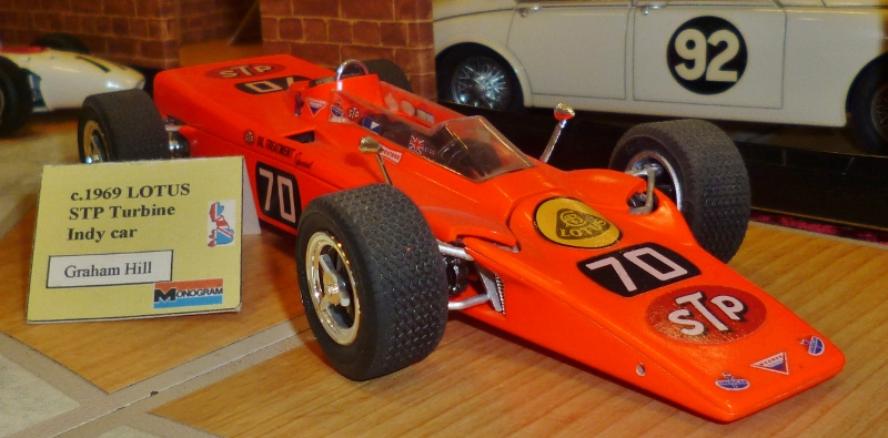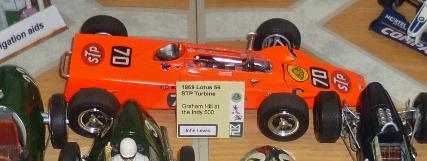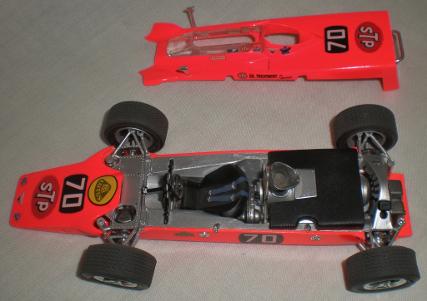
1968 Lotus 56 Indy 500 Turbine
In 1967 the STP-Paxton Turbine powered car ("Silent Sam") almost won the Indy 500 and Colin Chapman took note. The Lotus 38 had had it s day, successful as it had been it was time for something new. He came up with new ideas for an entirely new and more advanced design. For all Chapman's ideas it was Maurice Philippe who actually designed the Lotus 56 for the 1968 Indianapolis 500.
USAC had also noted the apparent ease with which the STP-Paxton turbine had lead the 1967 race and decided to change some of the rules to keep the racing even. Chief amongst them being to drastically reduce the air intake size in order to restrict power.
The Lotus 56 made up for this power reduction by having a sophisticated suspension layout and being light in weight. Advanced aerodynamics were pressed into service and a Ferguson 4wd traction system was employed to help with cornering grip and speed.
Having lost the services of both Jim Clark and Mike Spence in tragic accidents (Clark in an F2 race at Hockenheimring and Spence while testing the 56 at Indianapolis), Lotus only had Graham Hill of their regular driver line up left. To back him up they drafted in Joe Leonard, a former multiple winner of the A.M.A Grand National Championship motorcycle series, and Art Pollard. Both reasonably experienced Indy drivers at this point in their careers.
In qualifying Graham Hill, the 1966 champion, went first and immediately set a new qualifying record. Later, his STP Lotus teammate Joe Leonard grabbed the pole position with a speed of 171.559mph (276.097km/h). Still, first and second on the grid was a good start.
In the race the turbine cars were relatively evenly matched with the top contenders, mostly because of the aerodynamics and the 4wd chassis design. At the start Leonard took off in the lead followed by Bobby Unser and Roger McCluskey who had moved up to third by the end of lap 1. Lap 41 saw the first caution flag when Al Unser lost a wheel and hit the wall at turn one. At around the 200 mile mark A.J.Foyt blew his engine and his hopes for a fourth Indy title went up in smoke. One champion was followed out by another as on lap 110 Graham Hill lost a wheel and turned into the wall at turn two, bringing out the second caution. After several more incidents and retirements the last round of pitstops came up. Bobby Unser lost time with his car being stuck in gear so he struggled to get going again. This let both Leonard and Lloyd Ruby pass him. Things are looking good for Team lotus. Then with 16 laps to go Carl Williams hit the wall on the backstretch bringing out the final caution flag. At the restart both the remaining STP-Lotus 56 cars lurched forward then ground to a halt with the same problem, broken fuel pump drive shafts.









MPC first released this kit in 1968 almost as soon as the car had turned so many heads at that years Indy 500. It was then listed as kit # 800-150, and it proved very popular. Those who missed out on buying one of these kits had to wait until 1995 for MPC to do a re-release of the kit, # 6025, unchanged from the original apart from the box. Decals in both cases being for the Graham Hill car and ignoring Joe Leonard completely.
In 2003 AMT/ERTL released the same kit but with different decals. Kit # 31919 is of a white turbine with race number 50 on the sides. The box has “Buyers Choice” logos and the same script in French too suggesting this was a release made in response to pressure from the buying public.
One thing is certain, the kit remains very desirable for the Indy racing version and for conversion to the Lotus 56B F1 car.
This model was built in the 1990s straight from the box by the late John Lewis. John was the leader of the IPMS(UK) Car and Motorcycle Special Interest Group for many years and a fantastic model maker. An inspiration to many modellers his enthusiasm was matched only by the humble way he approached his peers.

